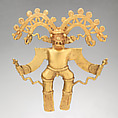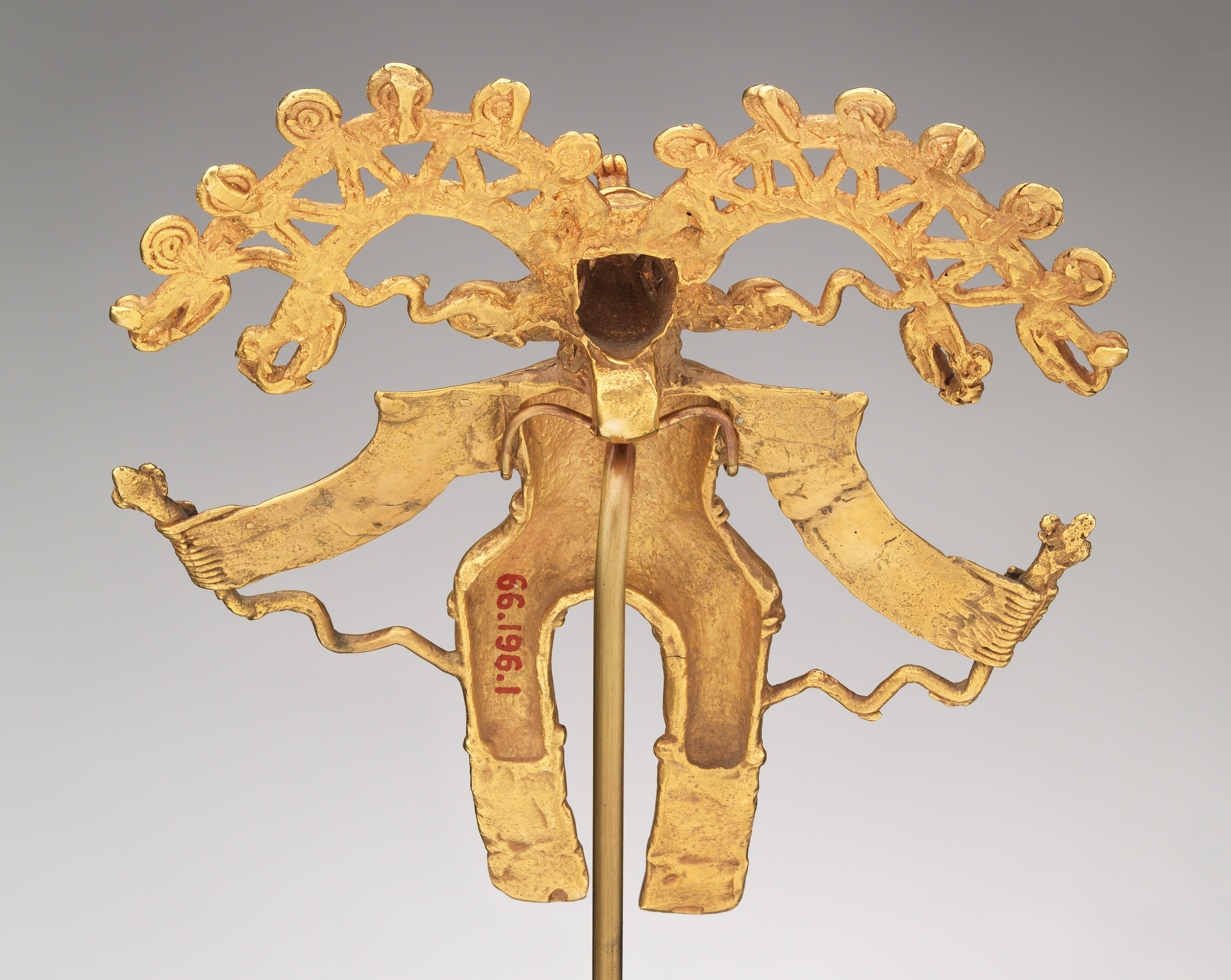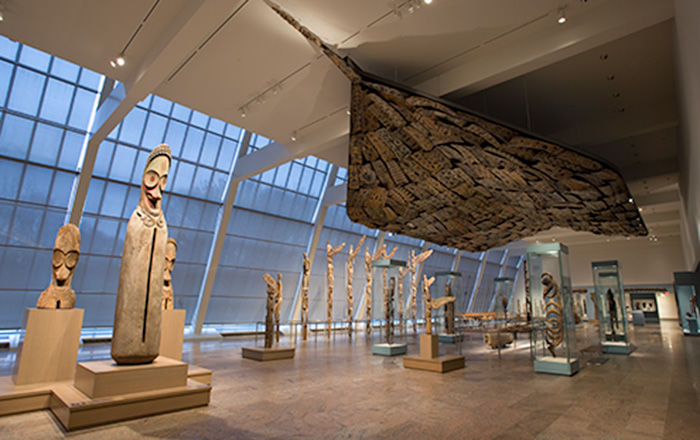Crocodile-head figure pendant
Para español, véase más abajo.
This pendant depicts an anthropomorphic figure with a crocodile-shaped face, holding a serpent in each hand. Other serpent-like features emerge from the head of the main figure; however, those too have crocodilian heads. Spirals adorn the ears and the top of the piece. A small ring behind the head, invisible from the front view, would allow this object to hang from a cord so it could be worn as a pendant.
The combination of textures and the contrast between bidimensional and tridimensional features show the range of skills as well as the creativity of the artist. This pendant was first cast using the lost-wax technique, including the delicate filigree detail, and then some elements, such as the arms, were hammered flat.
The gold-working technology used in the Chiriquí region (southern Costa Rica and western Panama) was first developed in Colombia around 100 BCE. Although some themes and styles are shared across this vast territory, specific styles emerged in several regions after approximately 500 CE. Small but extremely intricate body adornments were the preferred products of gold working in this area. These objects were often funerary offerings and possibly used by high status individuals during their lifetime.
Amanda Suárez Calderón, 2025
Further Reading
Fernández Esquivel, Patricia. Oro de Costa Rica: Metalugia y orfebrería en la época precolombina. San José, Costa Rica: Fundación Museos Banco Central, 2015.
Pillsbury, Joanne, Timothy Potts, and Kim N. Richter, eds. Golden Kingdoms. Luxury Arts in the Ancient Americas. Los Angeles: The J. Paul Getty Museum and The Getty Research Institute, 2017.
McEwan, Colin, and John Hoopes, eds. Pre-Columbian Art from Central America and Colombia at Dumbarton Oaks. Washington, DC: Dumbarton Oaks Research Library and Collection, 2021.
Este pendiente representa una figura antropomorfa con el rostro en forma de cocodrilo que sostiene una serpiente en cada mano. De su cabeza salen elementos que asemejan serpientes, pero también con forma de cocodrilo al final. Las orejas y la parte superior de la figura están adornadas con espirales. Un pequeño anillo en la parte posterior, invisible desde el frente, habría permitido colgar esta pieza de una cuerda y usarla como pendiente.
La combinación de texturas y el contraste entre los componentes bidimensionales y tridimensionales en esta figura muestran la gama de habilidades del artista, así como su creatividad. Para fabricar este pendiente, incluyendo los detalles en filigrana fundida, se utilizó la técnica de la cera perdida. Algunos elementos, como los brazos, se aplanaron con la técnica de martillado.
La tecnología de orfebrería utilizada en la región Chiriquí (sur de Costa Rica y oeste de Panamá) se desarrolló primero en Colombia alrededor del año 100 AEC. Aunque algunas temáticas y estilos son compartidas a lo largo de este vasto territorio, ciertos estilos específicos surgieron in varias regiones aproximadamente después del 500 EC. Los productos de orfebrería preferidos en esta área fueron los adornos corporales pequeños, pero extremadamente intricados. Estos objetos eran en muchas ocasiones ofrendas funerarias y posiblemente fueron usados en vida por individuos de alto estatus.
Amanda Suárez Calderón, 2025
Lecturas adicionales
Fernández Esquivel, Patricia. Oro de Costa Rica: Metalugia y orfebrería en la época precolombina. San José, Costa Rica: Fundación Museos Banco Central, 2015.
Pillsbury, Joanne, Timothy Potts, and Kim N. Richter, eds. Golden Kingdoms. Luxury Arts in the Ancient Americas. Los Angeles: The J. Paul Getty Museum and The Getty Research Institute, 2017.
McEwan, Colin, and John Hoopes, eds. Pre-Columbian Art from Central America and Colombia at Dumbarton Oaks. Washington, DC: Dumbarton Oaks Research Library and Collection, 2021.
This image cannot be enlarged, viewed at full screen, or downloaded.
This artwork is meant to be viewed from right to left. Scroll left to view more.



